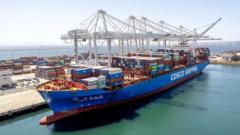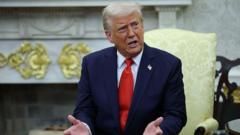China's export controls on crucial minerals, including lithium and cobalt, reveal the country's dominant role in the global renewable energy landscape.
The Impact of China's Export Ban on Critical Minerals

The Impact of China's Export Ban on Critical Minerals
China's recent export restrictions are sending shockwaves through the global energy transition, significantly affecting the supply of rare earth minerals.
April 17, 2025, 4:28 p.m. ET
In the history of science, one notable discovery dates back to 1886 when French chemist Paul-Émile Lecoq de Boisbaudran successfully extracted dysprosium, an element critical for modern technology, including the powerful magnets that power wind turbines and electric vehicles. Fast forward to today, dysprosium and several other rare earth elements are in the spotlight following China's announcement of export controls that will severely limit global access to these vital resources.
The export ban comes as part of China's response to President Trump imposing heavy tariffs, underscoring the fragile relationship between global supply chains and international trade policies. The situation reveals an alarming truth: As the world pushes to curb climate change, it is increasingly reliant on raw materials sourced from China.
Beyond rare earths, the impact of this ban extends to over half of the 50 minerals considered critical to the U.S. economy and national security. Among these are essential elements such as lithium, cobalt, and nickel, which power electric vehicles and renewable energy storage systems. China not only holds a significant portion of the world's supply but also holds investments in countries rich in these minerals, such as Indonesia for nickel, the Democratic Republic of Congo for cobalt, and Zimbabwe for lithium.
The unfolding scenario raises urgent questions about the sustainability and security of global energy transitions, particularly for countries relying heavily on materials from China. The interconnectedness of international trade and climate initiatives is more apparent than ever as nations scramble to adapt to the evolving landscape of mineral supply amidst geopolitical tensions.
In the history of science, one notable discovery dates back to 1886 when French chemist Paul-Émile Lecoq de Boisbaudran successfully extracted dysprosium, an element critical for modern technology, including the powerful magnets that power wind turbines and electric vehicles. Fast forward to today, dysprosium and several other rare earth elements are in the spotlight following China's announcement of export controls that will severely limit global access to these vital resources.
The export ban comes as part of China's response to President Trump imposing heavy tariffs, underscoring the fragile relationship between global supply chains and international trade policies. The situation reveals an alarming truth: As the world pushes to curb climate change, it is increasingly reliant on raw materials sourced from China.
Beyond rare earths, the impact of this ban extends to over half of the 50 minerals considered critical to the U.S. economy and national security. Among these are essential elements such as lithium, cobalt, and nickel, which power electric vehicles and renewable energy storage systems. China not only holds a significant portion of the world's supply but also holds investments in countries rich in these minerals, such as Indonesia for nickel, the Democratic Republic of Congo for cobalt, and Zimbabwe for lithium.
The unfolding scenario raises urgent questions about the sustainability and security of global energy transitions, particularly for countries relying heavily on materials from China. The interconnectedness of international trade and climate initiatives is more apparent than ever as nations scramble to adapt to the evolving landscape of mineral supply amidst geopolitical tensions.






















